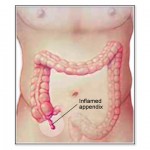Symptoms of Appendicitis in Children
 Appendicitis is a medical emergency which can occur in a person of any age. Generally children are more affected by this problem. This is a condition which results in inflammation of the appendix. When such a condition is detected in a child it is necessary to go in for treatment immediately otherwise there are chances of it getting out of hand. As per statistics the untreated mortality rate is quite high because of rupture due to shock. At a time it was considered that the acute abdominal pain is a caused by appendicitis but study has revealed that it can be even without much pain.
Appendicitis is a medical emergency which can occur in a person of any age. Generally children are more affected by this problem. This is a condition which results in inflammation of the appendix. When such a condition is detected in a child it is necessary to go in for treatment immediately otherwise there are chances of it getting out of hand. As per statistics the untreated mortality rate is quite high because of rupture due to shock. At a time it was considered that the acute abdominal pain is a caused by appendicitis but study has revealed that it can be even without much pain.
What causes appendicitis in children?
Appendix is an organ present in the body which is generally of the size of a finger. It is attached to the larger intestine and located at the lower end of abdomen. The appendix opens in the large intestine and the particles of food etc which enter into it get emptied in the large intestine. If the opening gets blocked due to any reason, the problem starts with development of bacteria and inflammation inside the appendix. This results in pain in the abdominal region. This problem generally occurs in kids in the age group of 11 to 20 and the chances of its occurrence increases between the months of October and May due to weather conditions.
Early signs of appendicitis in children
Stomach ache in children may be due to any other reason also, this can be confirmed by a specialist doctor only. However, the first symptom of appendicitis is pain in the mid abdominal region and tends to localize in the right side after few hours, followed by vomiting and fever. Disturbed bowl is another symptom of occurrence of this disease. The abdominal wall of the patient gets very sensitive and the patient tends to scream even on mild touch. In certain cases due to formation of gas, on touching the patient feels no pain as the pressure does not reach the appendix region. The pain is not that severe in older patients and kids below age of three.
Diagnosing and treatments
In most of the cases surgery is the only option available for treatment of this condition. Surgery can be performed by two methods. These are:
Open surgery this method involves preparing the patient for surgery. The patient is advised to refrain from eating or drinking anything. He is provided hydration by intravenous drip and antibiotics and other medicines are also injected in the drip. This helps reduce spread of infection and post operative infection can also be avoided this way. For this surgical process general anaesthesia is given if the patient has not eaten anything for six or more hours, otherwise spinal anaesthesia is given. The risks of it becoming fatal are only 3% in non rupture cases which can go up to 60% in rupture cases. The stay in hospital can range from few days to a week, depending upon the condition of the patient.
Laparoscopic surgery is a newer method for treatment of appendix. This is less painful and the patient recovers fast. The process involves making 3 or 4 holes in the abdomen, each being about half inch in size. Surgical tools are inserted and the infected portion is removed by surgical instruments. The surgery is done under general anaesthesia and takes about two hours, with another day or two of hospitalisation.
Since the pain is severe, the appendix patient has to be administered strong medicines to relieve the pain. In extreme cases, both in case of adults and children, morphine is also administered. The older practice of not administering pain relieving medicines is losing acceptability and the patient is not exposed to severe pain for hours together. Moreover, it has been found that medication for pain management does not interfere with the process of surgical evaluation.
To ascertain as to if the patient is suffering from appendix, a blood test is done. In about 50% of cases the blood tests are normal. Generally blood count is checked and excessive count results in conclusion of or points toward existence of appendicitis. Generally urine test does not reveal any symptoms. In about 10% cases normal X ray analysis may reveal hard formed faeces in the affected area, but this is not certain to arrive at a conclusion to operate the patient. Barium analysis may be helpful if facility of ultrasound is not available.
Ultrasound and Doppler sonography are generally the methods to ascertain the presence of the condition, especially in children. In color Doppler the appendix is visible and recorded. In case of excess filling of gas or bowl in intestines, appendix may not be so clearly visible but this is considered the surest method.
One can conclude that if there is pain in the abdomen region and it becomes severe and unbearable in children, an immediate examination by the surgeon is called for to avoid further complications.